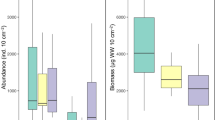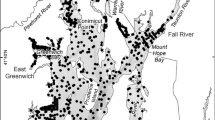Abstract
If the concepts of biological indices and biomonitoring at the multi-species level are to prove viable, then meiofauna and marine nematodes in particular should be an ideal group with which to test the hypothesis. Many attempts to assess the structure of species assemblages, such as the use of diversity indices, nematode: copepod ratios and the graphical method of log normal plots, have been shown to be theoretically unsound and/or impractical, especially for routine use by extension workers. A method of assessing shifts in dominance patterns which involves all the proportional species abundances is suggested as a better means of comparing diversity. A modified method of rapidly assessing Simpson's dominance-weighted diversity index is also advocated as being of practical use. In combination, they should enable the diversity aspect of the multi-species approach to biomonitoring to be rigorously and exhaustively evaluated.
Similar content being viewed by others
References
Amjad, S. & J. S. Gray, 1983. Use of the nematode-copepod ratio as an index of organic pollution. Mar. Pollut. Bull. 14: 178–181.
Cairns, J. Jr., 1981. Biological monitoring, 6. Future needs. Wat. Res. 15: 941–952.
Cairns, J. Jr., 1982. Biological monitoring in water pollution. Pergamon Press, Oxford, pp.
Cairns, J. Jr., D. W. Albaugh, F. Busey & M. D. Chanay, 1968. The sequential comparison index — a simplified method for non-biologist to estimate relative differences in biological diversity in stream pollution studies. J. Wat. Pollut. Cont. Fed. 40: 1607–1613.
Cairns, J. Jr. & K. L. Dickson, 1971. A simple method for the biological assessment of the effects of waste discharges on aquatic bottom-dwelling organisms. J. Wat. Pollut. Cont. Fed. 43: 755–772.
Coull, B. C., G. R. F. Hicks & J. B. J. Wells, 1981. Nematode: copepod ratios for monitoring pollution: a rebuttal. Mar. Pollut. Bull. 12: 378–381.
Dennis, B. & G. P. Patil, 1979. Species abundance, diversity, and environmental predictability. In J. F. Grassle, G. P. Patil, W. Smith & C. Taille (eds.), Ecological Diversity in Theory and Practice. International Co-operative Publishing House, Burtonsville: 93–114.
Ferris, V. R. & J. M. Ferris, 1979. Thread worms (Nematoda). In C. W. Hart & S. L. H. Fuller (eds.), Pollution Ecology of Estuarine Invertebrates. Academic Press, Lond.: 1–33.
Gray, J. S., 1981. The Ecology of Marine Sediments. Cambridge University Press, 185 pp.
Gray, J. S. & F. B. Mirza, 1979. A possible method for detecting pollution-induced disturbances in marine benthic communities. Mar. Pollut. Bull. 10: 142–146.
Hennig, H. F.-K., J. A. Eagle, L. Fielder, A. H. Fricke, W. J. Gledhill, P. J. Greenwood & M. J. Orrens, 1983. Ratio and population density of psammolittoral meiofauna as a perturbation indicator of sandy beaches in South Africa. Envir. monit. Ass. 3: 45–60.
Herricks, E. E. & J. Cairns, Jr., 1982. Biological monitoring, 3. receiving system methodology based on community structure. Wat. Res. 16: 141–153.
Huston, M., 1979. A general hypothesis of species diversity. Am. Nat. 113: 81–101.
Kempton, R. A. & L. R. Taylor, 1974. Log-series and log-normal parameters as diversity discriminants for the Lepidoptera. J. anim. Ecol. 43: 381–399.
Lambshead, P. J. D., H. M. Platt & K. M. Shaw, 1983. Detection of differences among assemblages of benthic species based on an assessment of dominance and diversity. J. nat. Hist., Lond. 17: 859–874.
MacArthur, R. H., 1972. Geographical Ecology. Harper & Row, N.Y.
May, R. M., 1975. Patterns of species abundance and diversity. In M. L. Cody & J. M. Diamond (eds.), Ecology and Evolution in Communities. Belknap Press, Cambridge, Mass.: 81–120.
Mirza, F. B. & J. S. Gray, 1981. The fauna of benthic sediments from the organically enriched Oslofjord, Norway. J. exp. mar. Biol. Ecol. 54: 181–207.
Patil, G. P. & C. Taillie, 1976. Ecological diversity; concepts, indices, and applications. Proc. 9th int. biometric conf., Boston.
Patil, G. P. & C. Taillie, 1977. Diversity as a concept and its implications for random communities. Bull. int. statist. Inst. 47: 497–515.
Platt, H. M., 1977. Ecology of free-living marine nematodes from an intertidal sanflat in Strangford Lough, Northern Ireland. Estuar. coast. mar. Sci. 5: 685–693.
Platt, H. M. & R. M. Warwick, 1980. The significance of freeliving nematodes to the littoral ecosystem. In J. H. Price, D. E. G. Irvine & W. F. Farnham (eds.), The Shore Environment, 2. Ecosystems. Academic Press, Lond.: 729–759.
Platt, H. M. & R. M. Warwick, 1983. Freeliving marine nematodes, 1. British enoplids. In D. M. Kermack & R. S. K. Barnes (eds.), Synopses of the British Fauna (New Series). Cambridge University Press 28: 303 pp.
Raffaelli, D., 1981. Monitoring with meiofauna — a reply to Coull, Hicks and Wells (1981) and additional data. Mar. Pollut. Bull. 12: 381–382.
Raffaeli, D., 1982. An assessment of the potential of major meiofauna groups for monitoring organic pollution. Mar. Envir. Res., 7: 151–164.
Raffaelli, D. G. & C. F. Mason, 1981. Pollution monitoring with meiofauna, using the ratio of nematodes to copepods. Mar. Pollut. Bull., 12: 158–163.
Shaw, K. M., P. J. D. Lambshead & H. M. Platt, 1983. Detection of pollution-induced disturbance in marine benthic assemblages with special reference to nematodes. Mar. Ecol. Prog. Ser. 11: 195–202.
Warwick, R. M., 1981. The nematode: copepod ratio and its use in pollution ecology. Mar. Pollut. Bull. 12: 329–333.
Author information
Authors and Affiliations
Rights and permissions
About this article
Cite this article
Platt, H.M., Shaw, K.M. & Lambshead, P.J.D. Nematode species abundance patterns and their use in the detection of environmental perturbations. Hydrobiologia 118, 59–66 (1984). https://doi.org/10.1007/BF00031788
Published:
Issue Date:
DOI: https://doi.org/10.1007/BF00031788




